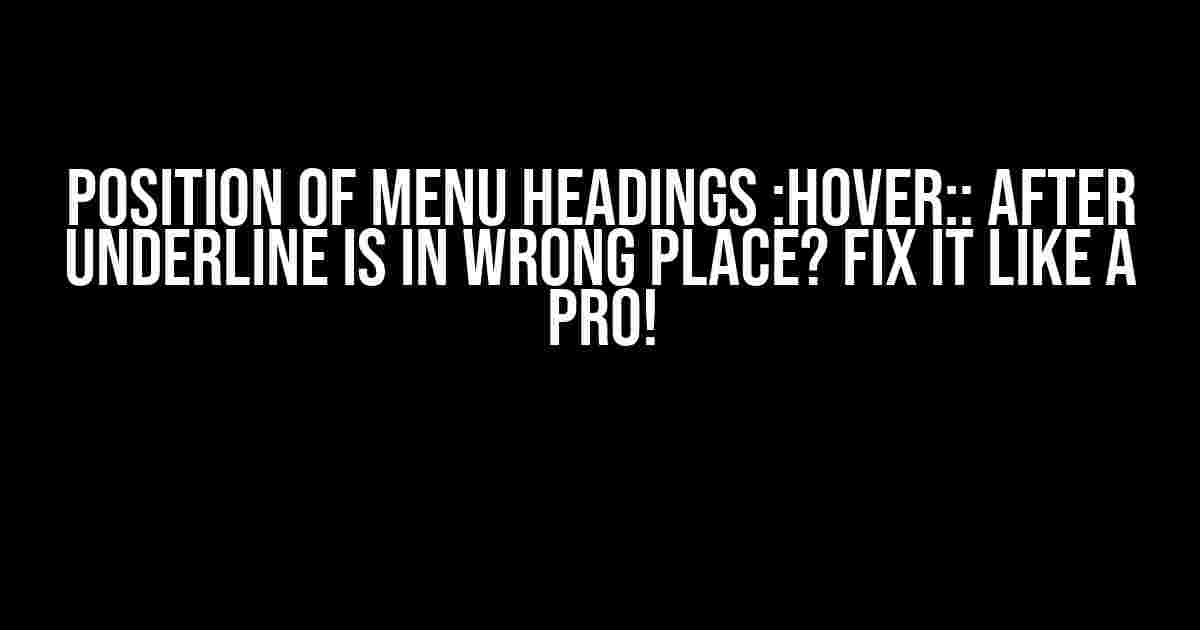Welcome to the world of CSS woes! If you’re reading this, you’re probably struggling with one of the most frustrating styling conundrums: the pesky position of menu headings’ :hover::after underline being in the wrong place. Don’t worry, friend, you’re not alone, and we’re about to tackle this issue like a boss!
What’s the Problem?
When you apply the :hover pseudo-class to a menu heading (usually an <a> or <li> element), the :after pseudo-element is supposed to add a nice, stylish underline. But, more often than not, that underline ends up in the wrong spot, ruining the entire design. It’s like the CSS Gods are playing a cruel joke on us!
Why does this happen?
The reason behind this anomaly lies in the way browsers render the :after pseudo-element. By default, the generated content is placed as an inline element, which means it adopts the same baseline as its parent element. When you add an underline to the :after pseudo-element, it gets positioned relative to its own baseline, not the parent’s. This results in the underline being offset from the original element, creating the illusion that it’s in the wrong place.
Solution 1: The display: inline-block Hack
One of the simplest ways to fix the positioning issue is to set the display property of the :after pseudo-element to inline-block. This will make the generated content behave like an inline-block element, allowing us to position the underline correctly.
.menu-heading {
position: relative;
}
.menu-heading:hover:after {
content: "";
position: absolute;
bottom: 0;
left: 0;
width: 100%;
border-bottom: 1px solid #ccc;
display: inline-block;
}
This solution works like a charm, but it does have some limitations. If you have a dynamic width or a complex layout, using display: inline-block might not be the most reliable approach.
Solution 2: The flexbox Fix
Enter flexbox, the CSS layout savior! By using flexbox, we can create a flexible container that will position the underline correctly, regardless of the parent element’s width or layout.
.menu-heading {
position: relative;
display: flex;
flex-direction: column;
align-items: center;
}
.menu-heading:hover:after {
content: "";
position: absolute;
bottom: 0;
left: 0;
width: 100%;
border-bottom: 1px solid #ccc;
flex: 1;
}
In this solution, we set the parent element to use flexbox with a column direction and center alignment. Then, we make the :after pseudo-element a flex item and set its width to 100%. This ensures that the underline will always be positioned correctly, even if the parent element’s width changes.
Solution 3: The Positioning Powerplay
If you’re looking for a more robust solution that doesn’t rely on flexbox or inline-block, you can use positioning to create a custom underline container.
.menu-heading {
position: relative;
}
.menu-heading:hover:after {
content: "";
position: absolute;
left: 0;
bottom: -1px;
width: 100%;
border-bottom: 1px solid #ccc;
}
In this approach, we create a separate container for the underline using absolute positioning. By setting the bottom property to -1px, we ensure that the underline is positioned correctly, regardless of the parent element’s padding or border.
Additional Tips and Tricks
Now that we’ve covered the main solutions, let’s discuss some additional tips and tricks to help you master the art of menu heading underlines:
text-decorationvs.border-bottom: When using the :hover pseudo-class, it’s better to useborder-bottominstead oftext-decoration: underline. This gives you more control over the underline’s appearance and positioning.- Don’t forget about
transition! Add a smooth transition to your underline by applying a transition effect to the :hover pseudo-class. - Use
::beforeinstead of::afterif you want the underline to appear above the text. - Experiment with different underline styles by changing the
border-bottomproperties, such asborder-bottom-style,border-bottom-width, andborder-bottom-color.
| Solution | Pros | Cons |
|---|---|---|
| display: inline-block | Simple, easy to implement | Limited flexibility, might not work with dynamic widths |
| Flexbox Fix | Flexible, works with dynamic widths | Requires flexbox support, might be overkill for simple cases |
| Positioning Powerplay | Robust, highly customizable | Requires more code, might be overkill for simple cases |
Conclusion
There you have it, folks! With these three solutions and additional tips, you should be able to tackle the pesky issue of menu heading underlines being in the wrong place. Remember, the key to success lies in understanding how the :after pseudo-element works and adapting your approach to fit your specific design needs. Happy coding, and may the CSS forces be with you!
Which solution did you find most effective? Do you have any other CSS conundrums you’d like us to tackle? Share your thoughts in the comments below!
Here is the HTML code with 5 Questions and Answers about “Position of Menu Headings :hover:: after underline is in wrong place”:
Frequently Asked Question
Having trouble with the :hover: pseudo-class on your menu headings? Find your answers here!
Why is my :hover: underline not appearing under the menu heading?
This is likely due to the :hover: pseudo-class being applied to the wrong element. Make sure to apply it to the anchor tag () instead of the list item (
I’ve applied the :hover: pseudo-class to the anchor tag, but the underline is still not in the right place. What’s going on?
Double-check the positioning of your anchor tag. If it’s not displaying as an inline element, the underline might be appearing in the wrong place. Try adding display: inline; or display: inline-block; to your anchor tag’s CSS.
How can I adjust the thickness and style of the :hover: underline?
You can customize the appearance of the :hover: underline by adding CSS properties to your anchor tag’s :hover: pseudo-class. For example, you can use text-decoration: underline; to control the thickness and style of the underline, or border-bottom: 2px solid #color; to create a custom underline effect.
Can I use a pseudo-element (::after or ::before) to create a custom :hover: underline effect?
Yes, you can use the ::after pseudo-element to create a custom :hover: underline effect. For example, you can add a ::after pseudo-element to your anchor tag and style it with CSS to create a custom underline effect. This approach gives you more control over the appearance and behavior of the underline.
What’s the best way to debug my :hover: pseudo-class issues?
Use the browser’s developer tools to inspect the element and check the CSS rules being applied. This will help you identify any conflicts or issues with the :hover: pseudo-class. You can also try using the browser’s built-in CSS debugging features, such as the “Elements” tab in Chrome, to visualize the element’s box model and layout.
Let me know if you want me to make any changes!


